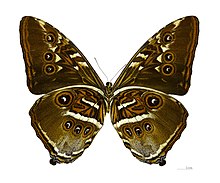Morpho hecuba
| Morpho hecuba | ||||||||||||
|---|---|---|---|---|---|---|---|---|---|---|---|---|

Morpho hecuba , male, upper side |
||||||||||||
| Systematics | ||||||||||||
|
||||||||||||
| Scientific name | ||||||||||||
| Morpho hecuba | ||||||||||||
| Linnaeus , 1771 |
Morpho hecuba is a butterfly ( butterflies )found in South Americafromthe noble butterfly family (Nymphalidae).
features
butterfly
Female moths of Morpho hecuba can reach a wingspan of up to 200 millimeters and thus make the largest specimens within the genus of Morphos . The sexes differ slightly in terms of coloration. The upper forewing of the males is reddish, on the outer edge darker and reddish brown spotted. From the wing root to about the middle of the wing there is a dark brown stripe on the front edge . In females, the basic color is a little lighter reddish and the front edge strip is paler. The upper side of the hind wing is gray-white in the basal region in both sexes , and dark red-brown towards the outer edge. There is a short, rounded tail at the anal corner. Specimens from Colombia are lighter in overall appearance. The undersides of the wings show a striking pattern, which consists of a reddish brown marbling, whitish stripes and spots as well as several differently sized, reddish rimmed eye spots .
Caterpillar
Adult caterpillars are brownish in color and have two broad, green, elongated spots on the back. The side stripes are also green. The body is covered with long, thin, gray hair along its entire length. Young caterpillars have dense brush-like hairs on the head.
Occurrence, habitat and subspecies
The species is found in tropical rainforests in northern South America . In addition to the nominate form Morpho hecuba hecuba , which is native to French Guiana , three other subspecies are known.
- Morpho hecuba obidonus Fruhstorfer , 1905, in Suriname and the Amazon
- Morpho hecuba polyidos Fruhstorfer , 1912, in Venezuela , Colombia and Brazil
- Morpho hecuba werneri Hopp , 1921, in southern Colombia and Ecuador .
Way of life
The moths prefer to fly in or over treetops and sometimes travel several kilometers in search of partners. The caterpillars feed on the leaves of the moon seed family (Menispermaceae). These contain toxins that are stored in the caterpillars, making them inedible for potential predators.
Individual evidence
- ↑ Morpho cisseis in comparison with other Morpho species
- ↑ occurrence
- ^ Butterflies of America
- ^ PJ DeVries, Carla M. Penz & Ryan I. Hill: Vertical distribution, flight behavior and evolution of wing morphology in Morpho butterflies , Journal of Animal Ecology, Volume 79, Issue 5, September 2010, pp. 1077-1085
Web links
- eol.org - Encyclopedia of Life
- animalcorner - Animalcorner
